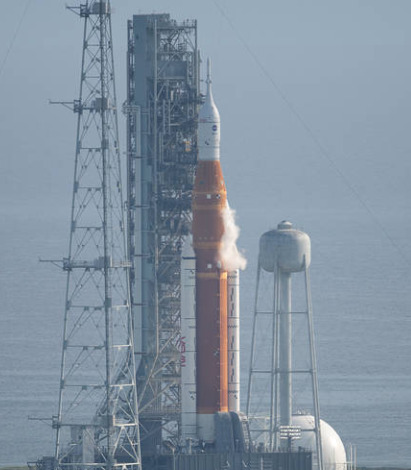2022-09-03 NASA

打ち上げ試行中に、エンジニアがSLSロケットの液体水素の充填と排出に使用する8インチのラインを囲む地上側とロケット側プレートの間の空洞から漏れを確認した。3回の再封印を試みましたが、失敗に終わりました。チルダウンと呼ばれる水素充填作業の初期段階において、マイナス423度の超低温液体水素をロケットのタンクに流し込む前に、発射管制官がラインと推進システムを冷却する際、不用意なコマンドを送信し、システム内の圧力が一時的に上昇した。ロケットは無事で、この圧力上昇がシール漏れの原因になったかどうかを判断するのは時期尚早ですが、エンジニアはこの問題を調査しています。
月への打ち上げには複雑な軌道力学が必要なため、NASAは現在の打ち上げ期間の一部として、9月6日(火)までにArtemis Iを打ち上げなければならなかったはずです。
<関連情報>
After standing down on today’s Artemis I launch attempt when engineers could not overcome a hydrogen leak in a quick disconnect, an interface between the liquid hydrogen fuel feed line and the Space Launch System (SLS) rocket, mission managers met and decided they will forego additional launch attempts in early September.
Over the next several days, teams will establish access to the area of the leak at Launch Pad 39B, and in parallel conduct a schedule assessment to provide additional data that will inform a decision on whether to perform work to replace a seal either at the pad, where it can be tested under cryogenic conditions, or inside the Vehicle Assembly Building.
To meet the requirement by the Eastern Range for the certification on the flight termination system, currently set at 25 days, NASA will need to roll the rocket and spacecraft back to the VAB before the next launch attempt to reset the system’s batteries. The flight termination system is required on all rockets to protect public safety.
During today’s launch attempt, engineers saw a leak in a cavity between the ground side and rocket side plates surrounding an 8-inch line used to fill and drain liquid hydrogen from the SLS rocket. Three attempts at reseating the seal were unsuccessful. While in an early phase of hydrogen loading operations called chilldown, when launch controllers cool down the lines and propulsion system prior to flowing super cold liquid hydrogen into the rocket’s tank at minus 423 degrees F, an inadvertent command was sent that temporarily raised the pressure in the system. While the rocket remained safe and it is too early to tell whether the bump in pressurization contributed to the cause of the leaky seal, engineers are examining the issue.
Because of the complex orbital mechanics involved in launching to the Moon, NASA would have had to launch Artemis I by Tuesday, Sept. 6 as part of the current launch period. View a list of launch windows here.



